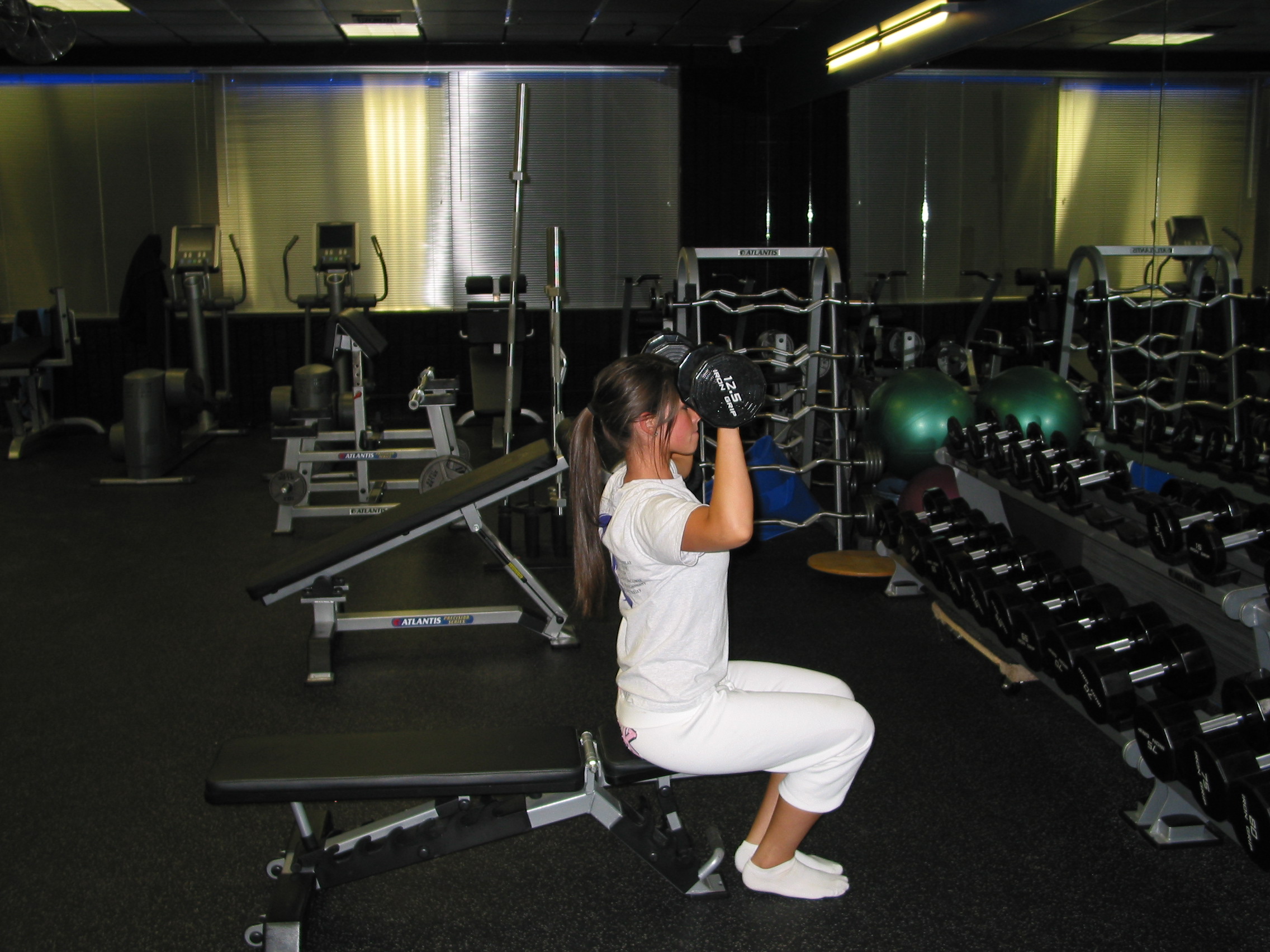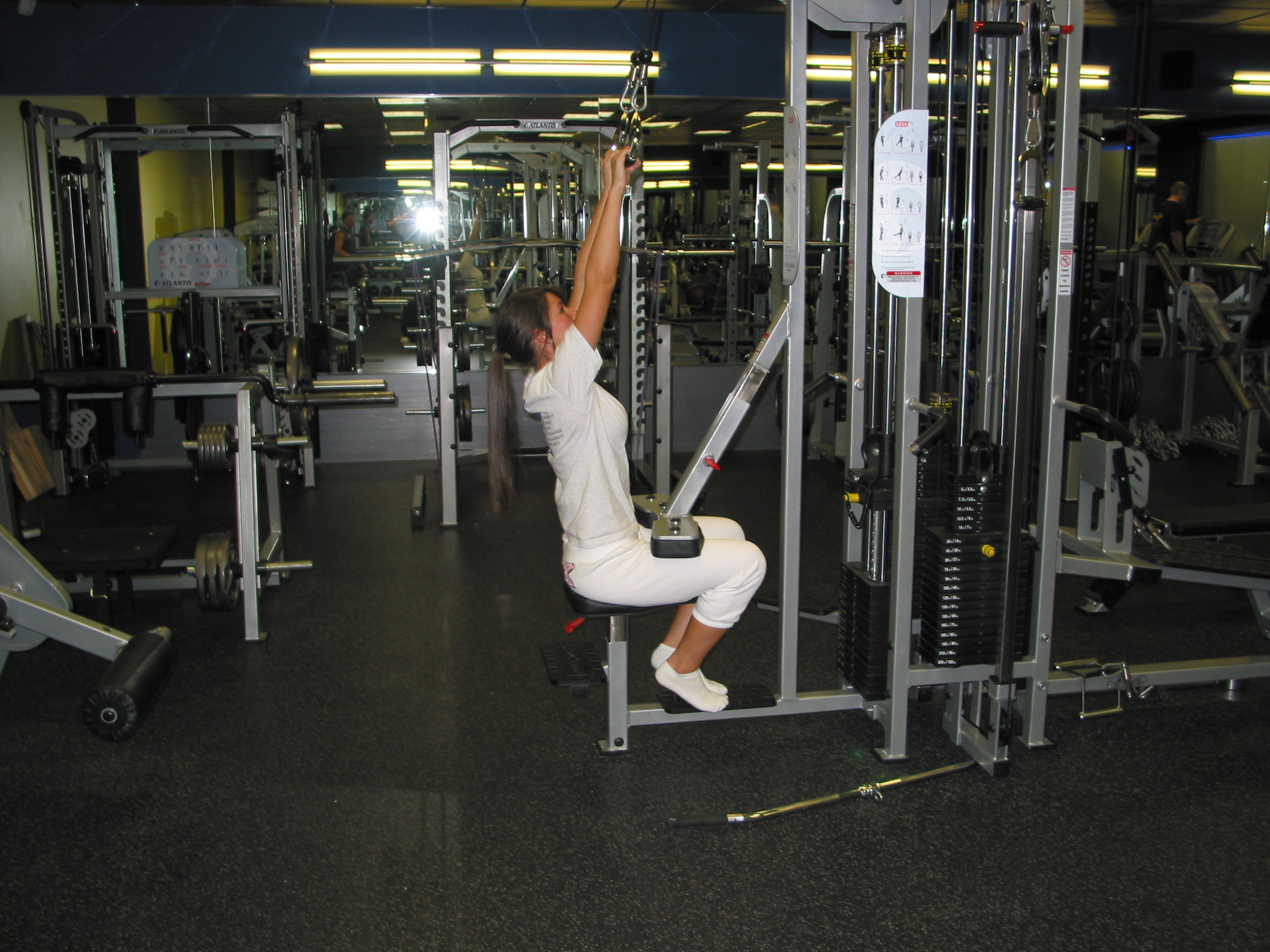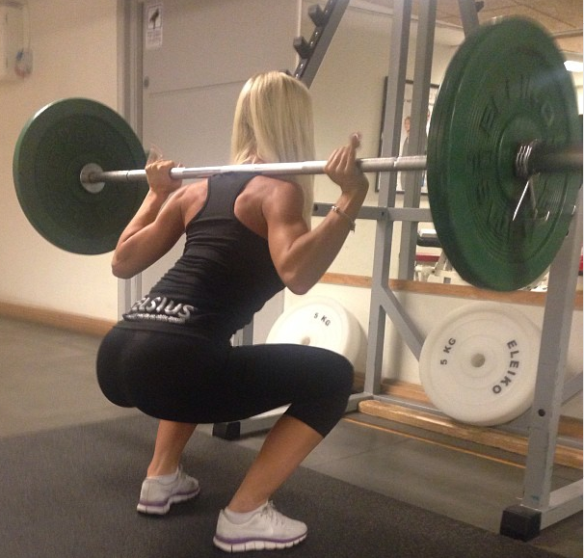Are you finding your clothes don’t fit you like they used to? Maybe they’re a little snug around the waist or tight in the rear. As adults age their metabolism slows down- mostly due to muscle mass loss, and weight gain commonly occurs. However, more women are discovering how to rev up their metabolism; weight training.
Weight training is a great way to give your metabolism a boost, burning more fat than any other exercise venue. When you combine weight training with a small amount of cardiovascular training (walking, cycling, or aerobics) and a goal-specific diet, you might change your body so fast that your friends and family no longer recognize you!
WHY WEIGHT TRAINING? Weight training helps you build muscle which burns more calories than fat. Your body continues to burn calories after lifting weights. The more muscle you have, the more calories you burn. The more muscle you have, the easier it is to burn fat. The more fat you carry, the easier it is to get fatter. Cardiovascular exercise may burn calories, but cardio DOES NOT build muscle. Sure, you may “tone up” the first few weeks you begin doing “cardio”, but it is a limited response. Women who do ONLY cardio may end up a size or so smaller, but usually FLABBIER too: they gain the weight back because the lack of stimulation to the muscle leads to a lowered metabolism. The idea is this: build some muscle by lifting weights. Then, when you do cardio, you will burn even more calories than before you had that extra muscle. One more thing to remember; TOO MUCH CARDIO BURNS MUSCLE. Most experienced physique athletes know that performing more than two 30-45 minute sessions of cardio per week can start eating away muscle after only 6-8 weeks. For more specific details, please read “Why Resistance Training“.
GENERAL WEIGHT TRAINING To drop bodyfat using free weights, it is generally recommended to lift 4-6 times per week, for 30-75 minutes per session, using weights that are 60-85% of your 1 rep max, with each set lasting 40-70 seconds (try the ABC Routine, or the XFL Program). If you are lifting properly, you should notice steady improvements in your body continually over time. The longer you commit to this form of exercise, the more you will benefit. And the changes you make will be longer lasting. Cardio can be added, but it IS NOT ALWAYS NECESSARY and can actually impede progress in many situations. If you MUST have cardio in your program (because you are psychologically addicted to it or you are routinely tested for cardiovascular fitness), try using cardio as a form of active recovery; a way to recover more quickly from your weight training sessions. Do 15-20 minutes of low intensity cardio on non-weight training days or in a separate training session, 2-3 times per week. Remember, when it comes to losing body fat, aerobic activity is a second rate activity. Weight training is number one. And, combining weight training and cardio in one 60 minute workout is a very common beginner mistake.
 BEWARE THE SCALE! It is only ONE of many TOOLS… The biggest challenge for many will be not to be dismayed by what the scale tells you in the short term. The scale is only ONE tool for assessing progress. You must also assess your total body fat, your strength levels, your waist size, and your general appearance (look in the mirror). When you weigh yourself, you must remember muscle weighs more than fat. Fat takes up ALOT more room than muscle. Women training with weights have been known to weigh the same as when they started, even while dropping from a size 12 to a size 6. Going by just the scale can be very deceiving. A woman who loses 10 lbs of fat and gains 10 lbs of muscle in the same training period will look DRAMATICALLY different. No need to worry about “bulking up” either; it just doesn’t happen to females who don’t use steroids. So forget about the excuse, “I don’t want to get too big.” If your arms are still big, it is because you still have a lot of fat to lose, not because you are curling 25 lbs. Bottom line: Use the a tailor’s tape to measure waist circumference – combining that information with your scale weight will give you a clearer picture of whether you are losing fat or not.
BEWARE THE SCALE! It is only ONE of many TOOLS… The biggest challenge for many will be not to be dismayed by what the scale tells you in the short term. The scale is only ONE tool for assessing progress. You must also assess your total body fat, your strength levels, your waist size, and your general appearance (look in the mirror). When you weigh yourself, you must remember muscle weighs more than fat. Fat takes up ALOT more room than muscle. Women training with weights have been known to weigh the same as when they started, even while dropping from a size 12 to a size 6. Going by just the scale can be very deceiving. A woman who loses 10 lbs of fat and gains 10 lbs of muscle in the same training period will look DRAMATICALLY different. No need to worry about “bulking up” either; it just doesn’t happen to females who don’t use steroids. So forget about the excuse, “I don’t want to get too big.” If your arms are still big, it is because you still have a lot of fat to lose, not because you are curling 25 lbs. Bottom line: Use the a tailor’s tape to measure waist circumference – combining that information with your scale weight will give you a clearer picture of whether you are losing fat or not.
ADDITIONAL BENEFITS OF WEIGHT TRAINING In addition to boosting the metabolism, giving you more energy, and dropping your body fat, weight training delivers many other health benefits. It helps prevent osteoporosis, a bone disease that affects many females after menopause, that results in bones becoming porous and fragile. Women who weight train build denser bones. This helps prevent osteoporosis and even reverses the earlier stages of the disease. Also, weight training done properly (not on MACHINES!) will help promote flexibility, mobility, and coordination; these qualities are crucial keeping a person injury free, healthy, and happy. Weight training has the potential to increase both the quantity and quality of life.
YOU CAN GET STARTED RIGHT NOW! Even if you don’t belong to a gym, you can start weight training now. Start with simple exercises done with just the body; sit-ups, leg raises, pushups, chinups, bodyweight squats, split squats, calf raises. This is resistance training in its most basic form. If this is too difficult, improvise, or substitute with similar exercises using dumbbells. Become familiar with basic body movements and postures. Tai Chi and Power Yoga are innovative activities that can help you gain this kind of familiarity with your body. There are also many books and videos on weight training available to help you learn the various exercises. Get recommendations on which ones to buy. Next, you might start building your own small home gym (learn to avoid common home gym mistakes) by purchasing metal or chrome dumbbells readily available at most sporting goods stores or a great online retailer. Start with 5 lb dumbbells. Then purchase another pair of dumbbells as your strength progresses, adding a pair of 10’s, 15’s, 20’s, 25’s, 30’s, etc. Eventually you will have collected a full set of dumbbells and drastically improved your body in the process. Round out this collection with a simple adjustable bench, squat racks, and a pull-down attachment. But I must warn you: PLEASE! DO NOT BUY ANY of this gimmicky gym equipment advertised on television infomercials. These “technological breakthroughs” are nothing but a clever way to separate you from your money. Despite their claims, no one ever got in shape by using only the scam product(s) they are promoting.
 THE MODERN FITNESS SHAM, AKA “$9.99 FITNESS” (read more about what I call “$9.99 FITNESS” HERE) Eventually you will “outgrow” your basic home gym, but try to avoid wasting your time, energy, and money on bad gym memberships and unqualified personal trainers. As a beginner, you are the perfect prey for the salesmen of the $10 a month fitness clubs. They will use your lack of experience against you to sell you a membership to a warehouse-sized “family fitness center” filled with the cheapest, lowest quality strength and cardio equipment money can buy. They will probably fail to mention that they have also sold memberships to absolutely EVERYONE they could get their hands on. Typically, gyms like these get SO CROWDED that you will often have to wait in line to use your favorite piece of cardio or strength station. Despite what they pitch you, you DO NOT need to use their “cutting edge” machines such as the hip adduction/abduction station or the butt blaster: most machines are a total waste of your time. In fact, using machines, as a beginner, is the most common and pervasive MISTAKE still perpetuated by the fitness and personal training industry.
THE MODERN FITNESS SHAM, AKA “$9.99 FITNESS” (read more about what I call “$9.99 FITNESS” HERE) Eventually you will “outgrow” your basic home gym, but try to avoid wasting your time, energy, and money on bad gym memberships and unqualified personal trainers. As a beginner, you are the perfect prey for the salesmen of the $10 a month fitness clubs. They will use your lack of experience against you to sell you a membership to a warehouse-sized “family fitness center” filled with the cheapest, lowest quality strength and cardio equipment money can buy. They will probably fail to mention that they have also sold memberships to absolutely EVERYONE they could get their hands on. Typically, gyms like these get SO CROWDED that you will often have to wait in line to use your favorite piece of cardio or strength station. Despite what they pitch you, you DO NOT need to use their “cutting edge” machines such as the hip adduction/abduction station or the butt blaster: most machines are a total waste of your time. In fact, using machines, as a beginner, is the most common and pervasive MISTAKE still perpetuated by the fitness and personal training industry.
All you really NEED to get in shape is your own body and, some free weights, the right space, and some proper instruction (for more details, go HERE). Of course, a PROPERLY EQUIPPED gym (whose owner(s) truly understand effective exercise) will have been built with proper introduction to the basics in mind and lots of extra goodies that can take your exercise program to a whole new level. CrossFit gyms are an example of this more sensible direction in fitness. Gymnast rings, kettle bells, and bumper plates are MUCH more useful and effective, for beginners, AND in the long term, than the Gravitron, Hammer Strength Stations, and Elliptical Cardio-Trainers.
“CERTIFIED PERSONAL TRAINERS” You definitely do NOT need one of those often “free”, gym-employed, “personal trainers” who think that coaching someone properly means having you perform 2-3 sets of 12-15 reps/set, with 3-4 exercises/bodypart on a circuit of shiny, toy-like, pin-selectorized machines. This is a VERY UNPRODUCTIVE use of your time. It is important for you to realize that starting off with improper instruction from a “certified personal trainer” could be the worst mistake of your exercise career. Choose a personal trainer or coach VERY carefully. A good coach, like anything else, costs money. Many “certified personal trainers” do NOT know what proper training is, despite looking in shape, and despite their multiple paper “certifications”. Look for other ways to assess their competency, such as the success rate of their current or past clients.
BE PROACTIVE Take an active role in your exercise and diet program. Beware – everybody is claiming to be a “fitness expert” these days, mostly so they can swindle you out of your hard-earned money. TEACH YOURSELF the basics using a simple, common sense approach; you’ll be happy you did. This is a life-long process. Remember, the only one standing between you and your goals is YOU! Everybody has a right to have a healthy, fit body. It doesn’t cost alot of money and it doesn’t happen over night. Take your time, learn, have confidence in what you’re doing; it will happen.
The most important thing I would like you to remember from this article is: if you want to efficiently and consistently burn fat, you must include some sort of resistance exercise (weight training) in your exercise program.
I wish you the best of luck.
Thank you for reading,
Paul NEWT
For more information about personal training, strength and conditioning services, please visit www.newtsystems.com.
To read my personal blog, full of awesome, practical insights and qualified expert advice, please find me at www.theperfect105.com


 I first wrote The ABC Routine in the mid-90’s. It is meant to be a quick and easy reference guide for anybody just returning to the
I first wrote The ABC Routine in the mid-90’s. It is meant to be a quick and easy reference guide for anybody just returning to the  INSTRUCTIONS
INSTRUCTIONS
















 Paul Newt has been privately instructing and strength coaching since 1994. He is the Founder of
Paul Newt has been privately instructing and strength coaching since 1994. He is the Founder of 
 BEWARE THE SCALE! It is only ONE of many TOOLS… The biggest challenge for many will be not to be dismayed by what the scale tells you in the short term. The scale is only ONE tool for assessing progress. You must also assess your total body fat, your strength levels, your waist size, and your general appearance (look in the mirror). When you weigh yourself, you must remember muscle weighs more than fat. Fat takes up ALOT more room than muscle. Women training with weights have been known to weigh the same as when they started, even while dropping from a size 12 to a size 6. Going by just the scale can be very deceiving. A woman who loses 10 lbs of fat and gains 10 lbs of muscle in the same training period will look DRAMATICALLY different. No need to worry about “bulking up” either; it just doesn’t happen to females who don’t use steroids. So forget about the excuse, “I don’t want to get too big.” If your arms are still big, it is because you still have a lot of fat to lose, not because you are curling 25 lbs. Bottom line: Use the a tailor’s tape to measure waist circumference – combining that information with your scale weight will give you a clearer picture of whether you are losing fat or not.
BEWARE THE SCALE! It is only ONE of many TOOLS… The biggest challenge for many will be not to be dismayed by what the scale tells you in the short term. The scale is only ONE tool for assessing progress. You must also assess your total body fat, your strength levels, your waist size, and your general appearance (look in the mirror). When you weigh yourself, you must remember muscle weighs more than fat. Fat takes up ALOT more room than muscle. Women training with weights have been known to weigh the same as when they started, even while dropping from a size 12 to a size 6. Going by just the scale can be very deceiving. A woman who loses 10 lbs of fat and gains 10 lbs of muscle in the same training period will look DRAMATICALLY different. No need to worry about “bulking up” either; it just doesn’t happen to females who don’t use steroids. So forget about the excuse, “I don’t want to get too big.” If your arms are still big, it is because you still have a lot of fat to lose, not because you are curling 25 lbs. Bottom line: Use the a tailor’s tape to measure waist circumference – combining that information with your scale weight will give you a clearer picture of whether you are losing fat or not. THE MODERN FITNESS SHAM, AKA “$9.99 FITNESS” (read more about what I call “
THE MODERN FITNESS SHAM, AKA “$9.99 FITNESS” (read more about what I call “
 TAI CHI
TAI CHI WEIGHT TRAINING
WEIGHT TRAINING


